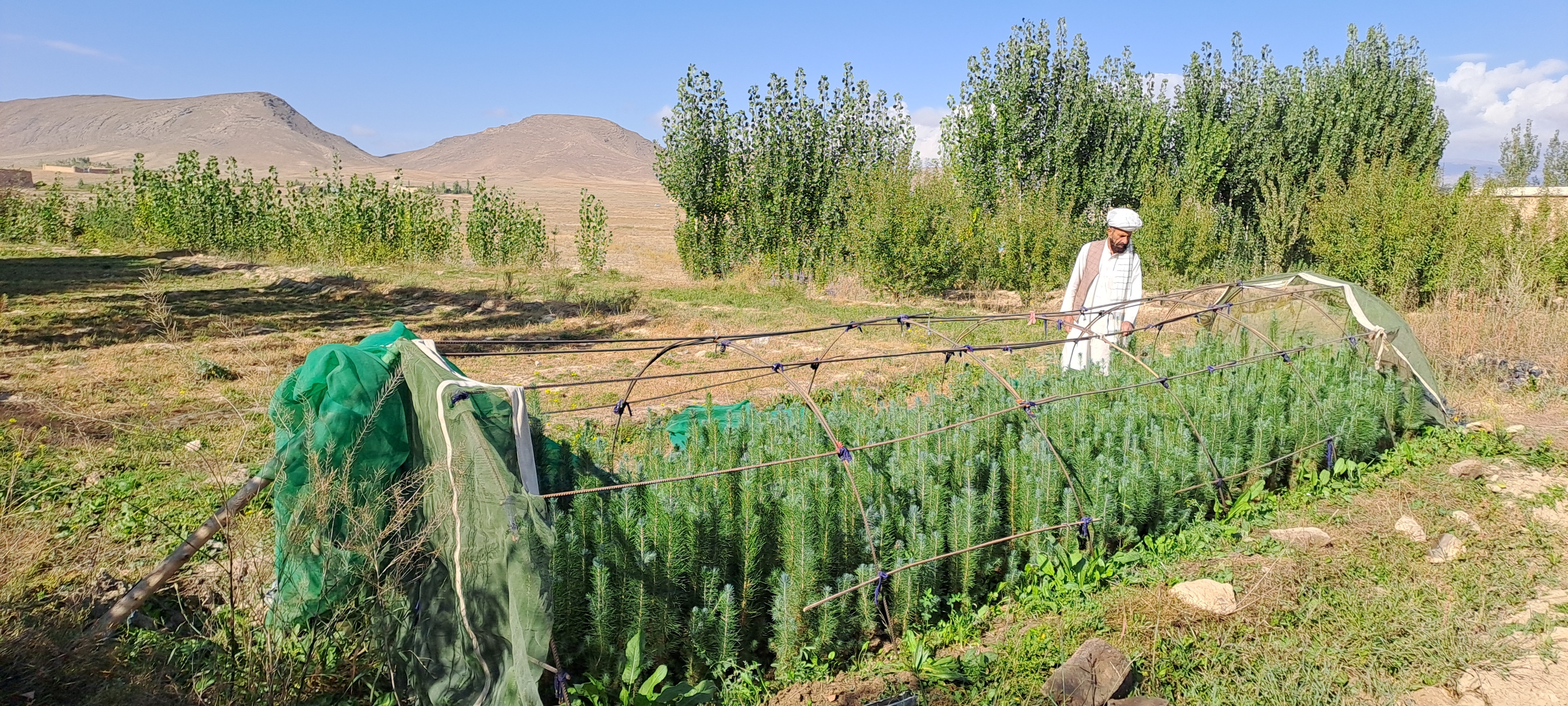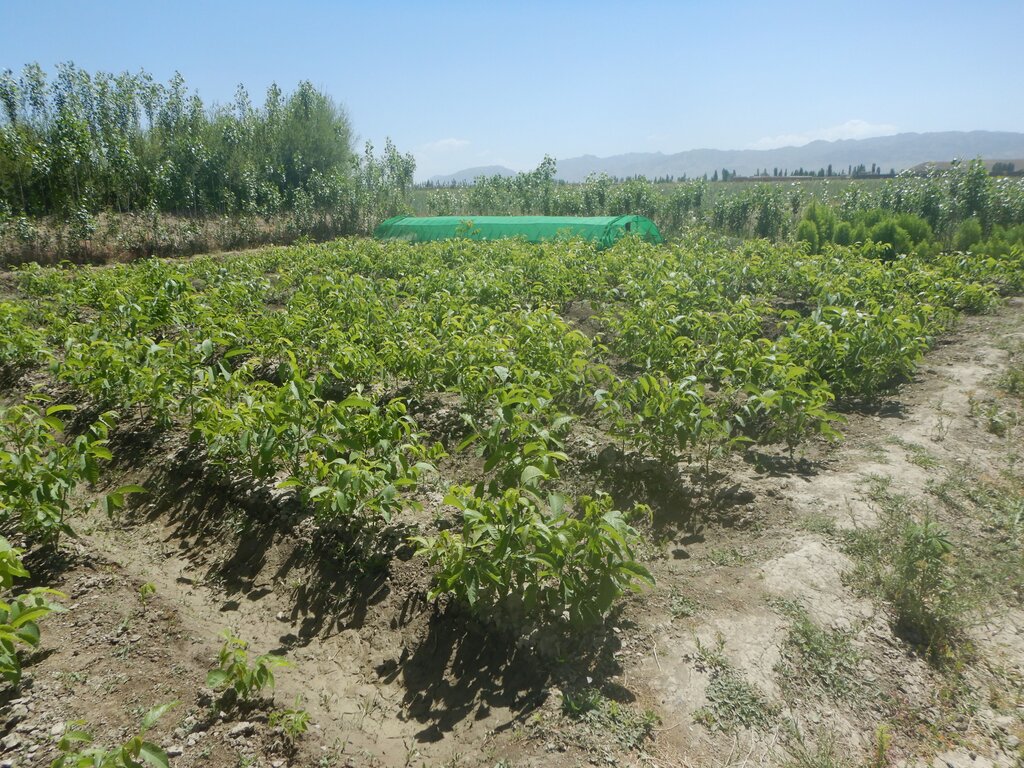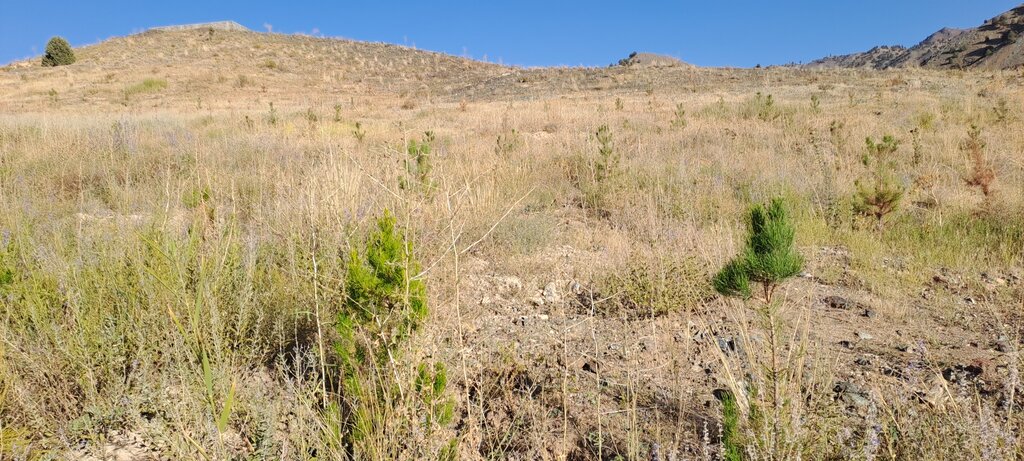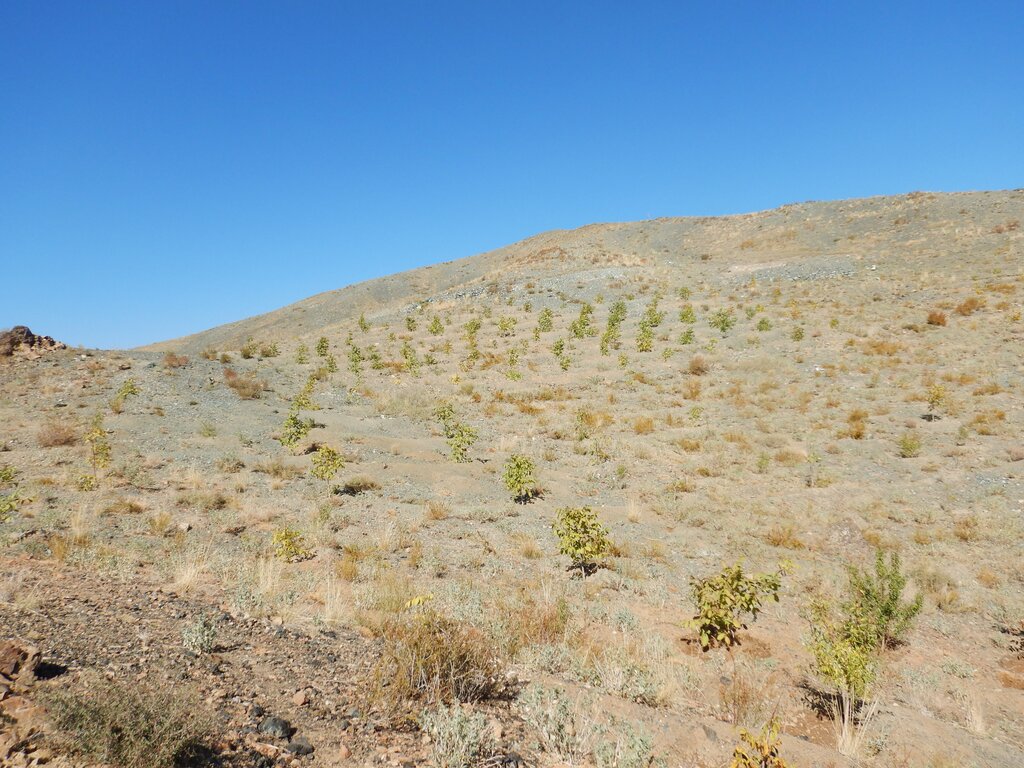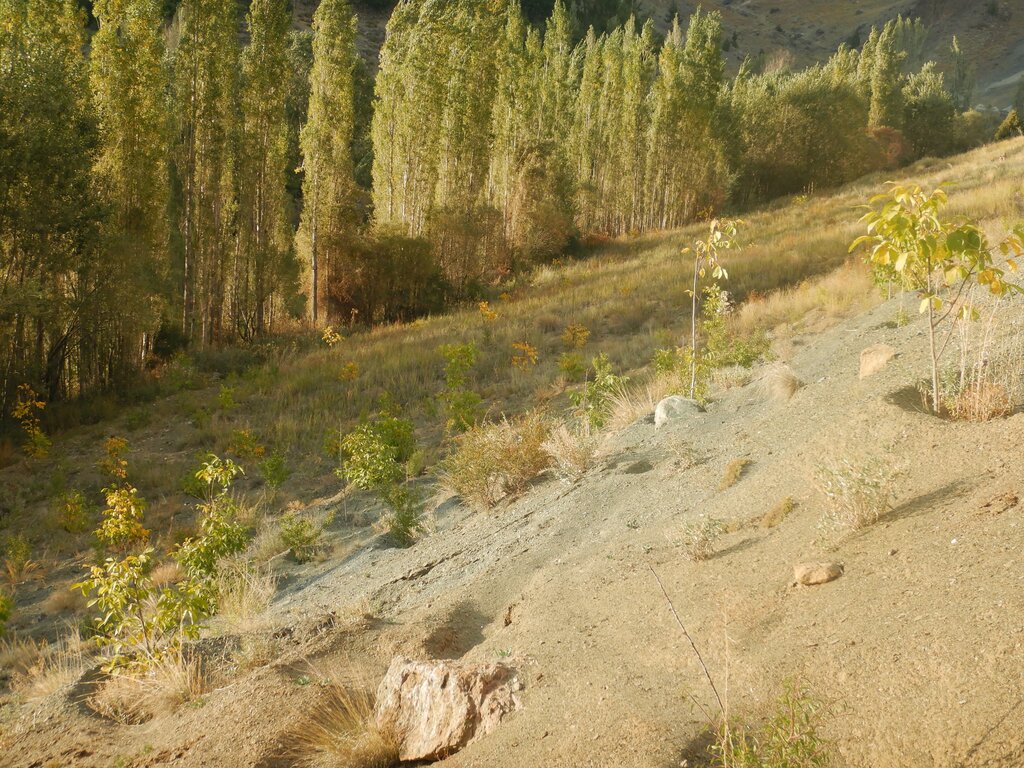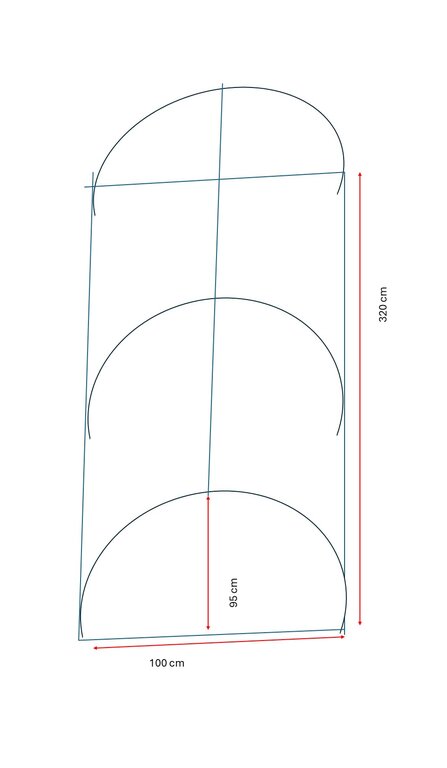Restoration in the High Conservation Value Forests (HCVF) through community-led initiatives in Paktya [Afganistán]
- Creación:
- Actualización:
- Compilador: Mohammad Wazir Ahmadzai
- Editores: Mir Wali Khan Lakanwal, Mohammad Mustafa Sahebzada, Megha Bajaj, Megha bajaj
- Revisores: Rima Mekdaschi Studer, Illias Animon, Muhammad Ishaq Safi
Chilghuza and Nakhter
technologies_7454 - Afganistán
- Resumen completo en PDF
- Resumen completo en PDF para imprimir
- Resumen completo en el navegador
- Resumen completo (sin formato)
- Restoration in the High Conservation Value Forests (HCVF) through community-led initiatives in Paktya: 5 de marzo de 2025 (inactive)
- Restoration in the High Conservation Value Forests (HCVF) through community-led initiatives in Paktya: 24 de marzo de 2025 (inactive)
- Restoration in the High Conservation Value Forests (HCVF) through community-led initiatives in Paktya: 7 de mayo de 2025 (public)
Visualizar secciones
Expandir todo Colapsar todos1. Información general
1.2 Detalles de contacto de las personas de referencia e instituciones involucradas en la evaluación y la documentación de la Tecnología
Persona(s) de referencia clave
usuario de la tierra:
Sayed Hakim Shah
Forest management Association
Afganistán
usuario de la tierra:
Sabawon Samiullah
Forest mangemnet Association
Afganistán
Nombre del proyecto que financió la documentación/ evaluación de la Tecnología (si fuera relevante)
Community-based sustainable land and forest management in AfghanistanNombre de la(s) institución(es) que facilitaron la documentación/ evaluación de la Tecnología (si fuera relevante)
FAO Afghanistan (FAO Afghanistan) - Afganistán1.3 Condiciones referidas al uso de datos documentados mediante WOCAT
El compilador y la/s persona(s) de referencia claves aceptan las condiciones acerca del uso de los datos documentados mediante WOCAT:
Sí
1.4 Declaración de la sostenibilidad de la Tecnología descrita
¿La Tecnología aquí descrita resulta problemática en relación a la degradación de la tierra, de tal forma que no puede considerársela una tecnología sostenible para el manejo de la tierra?
No
2. Descripción de la Tecnología MST
2.1 Breve descripción de la Tecnología
Definición de la Tecnología:
An integrated community-led initiative has been established to restore the degraded forests in Paktya province. This initiative focuses on setting up nurseries and incorporates both indigenous and scientific knowledge to cultivate climate-resilient species, such as Cedrus deodara and Pinus gerardiana. These efforts have enhanced the community’s knowledge and skills in sapling production and transplantation, leading to significant improvements in the productivity of these key species, which holds substantial ecological, social, cultural and economic values.
2.2 Descripción detallada de la Tecnología
Descripción:
The technology is applied in the communities of Ahmad Aba and Sayed Karam districts in the Paktya province, focusing on restoration of high conservation value forests. It is implemented through direct support of 13 Forest Management Associations (FMAs).
Key members of FMA participated in capacity building focused on community -based natural resources management (CBNRM), establishment of community-based nurseries and restoration of degraded forest .The aim of the capacity building initiative was to enhance the ability of the associations to restore the degraded area and implement sustainable practices, particularly through establishment of community-based nurseries, production of saplings and subsequent planting of these saplings in targeted restoration sites .
Over the past three years, 67 nurseries have been established, focusing on climate- resilient species such as Cedrus deodara, Pinus jerardiana, and Juglans regia, among others species by integrating both indigenous and scientific knowledge. Indigenous knowledge includes practices such as pre-irrigation, the use of animal-powered initial plowing with hand-held hoes, weed removal, and other traditional techniques. Scientific recommendations include improvement of sapling production, adaption of soil inoculation with Mycorrhiza, species-specific sowing methods, controlled temperature management in greenhouses, effective watering/irrigation techniques (manually and using sprinklers).
The project has significantly enhanced sapling production and transplantation for reforestation purposes. The community-based nurseries were established using carefully selected seeds, chosen based on seed quality, sowing timing, and the process of breaking seed dormancy. Saplings were then raised in the nurseries for the first 2 to 3 years until, they are ready for transplantation. These saplings are then transplanted to the degraded forest areas. The land preparation and digging of pits were carried out in the restoration sites before transplanting saplings. After transplanting, FMAs took care of the saplings. Additionally, mechanical pests and diseases control measures were employed to produce good-quality saplings in community-based nurseries. These interventions raised community awareness on forest condition and management and thereby enhanced their capacities to improve the forest cover.
Major activities include site assessment and pre-planning, selection of high conservation value tree species, site selection, technical training on site management (preparation of soil, sowing method, irrigation management, greenhouse) and capacity building of the communities and beneficiaries on nursery soil mixture preparation, breaking of dormancy using different techniques, sapling production and transplantation.
The 13 Forest Management Associations (FMAs) are the legal institutions for the management of natural resources; they hold a license for reforestation activities in degraded forests. They are officially registered with Ministry of Agriculture, Irrigation and Livestock (MAIL). FMAs are responsible for implementing the restoration measures. These communities showed commitments for the transplantation, irrigation and regular patrolling of the saplings.
The goal of the restoration efforts is to enhance the capacity of the local community on methods of in-situ and ex-situ biodiversity conservation and creation of a recreational site. It also aimed to raise the awareness towards mitigation of climate change, and ultimately improve the livelihoods of rural populations. The application of technologies offers cost-effective and eco-friendly restoration of the high conservation value forest especially of pine (Pinus jerardiana) and deodar (Cedrus deodara). Additionally, it provided work opportunities and income generation for 100 families. The technology is well-suitable for replication and adaptation in the local context. As a result, the local community consistently produces the necessary saplings for reforestation and supplies them to the project at a reasonable cost every year.
2.3 Fotografías de la Tecnología
2.4 Videos de la Tecnología
Fecha:
09/12/2024
Lugar:
Afghanistan
Nombre del videógrafo:
Mohammad Wazir Ahmadzai
2.5 País/ región/ lugares donde la Tecnología fue aplicada y que se hallan comprendidos por esta evaluación
País:
Afganistán
Región/ Estado/ Provincia:
Paktya
Especifique más el lugar :
Ahmad Aba and Sayed Karam
Especifique la difusión de la Tecnología:
- aplicada en puntos específicos/ concentrada en un área pequeña
¿El/los sitio(s) de la Tecnología se ubica(n) en un área de protección permanente?
No
Comentarios:
In each forest management association, five community-based nurseries have been established, each covering less than 0.004 hectares. Once the saplings are ready for transplantation, typically after 2 to 3 years, they are transported from the nurseries to the restoration sites for planting. A total of 2,718 hectares of forest area have been restored in both Ahmad Aba and Sayed Karam districts. Community-based nurseries have been established in various villages and are being scaled up through the nursery owners to produce the saplings required for reforestation. The map highlights only these two districts.
Map
×2.6 Fecha de la implementación
Indique año de implementación:
2021
2.7 Introducción de la Tecnología
Especifique cómo se introdujo la Tecnología:
- mediante proyectos/ intervenciones externas
3. Clasificación de la Tecnología MST
3.1 Propósito(s) principal(es) de la Tecnología MST
- reducir, prevenir, restaurar la degradación de la tierra
- conservar el ecosistema
- preservar/ mejorar biodiversidad
- adaptarse al cambio climático/ extremos climáticos y sus impactos
- crear impacto económico benéfico
3.2 Tipo(s) actuales de uso de la tierra donde se aplica la Tecnología
Mezcla de tipos de uso de tierras dentro de la misma unidad de tierras: :
No

Bosques
- Plantación de árboles, reforestación
Plantación de árboles, reforestación: Especifique el origen y la composición de las especies:
- Variedades mixtas
tipo de plantación de árboles, reforestación:
- plantación de bosque subtropical seco - Pinus spp.
Tipo de árbol:
- Especies de Pinus (pino)
¿Los árboles especificados son deciduos o imperecederos?
- mixto deciduo/ imperecedero
Productos y servicios:
- Madera
- Leña
- Frutos y nueces
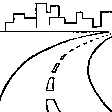
asentamientos, infraestructura
- plastic tunnels in nurseries
Comentarios:
The community-based nurseries are established in the village near to the forest areas.
3.3 ¿Cambió el uso de tierras debido a la implementación de la Tecnología?
¿Cambió el uso de tierras debido a la implementación de la Tecnología?
- No (Continúe con la pregunta 3.4)
3.4 Provisión de agua
Provisión de agua para la tierra donde se aplica la Tecnología:
- mixta de secano – irrigada
Comentarios:
Nurseries are irrigated. After transporting saplings, supplementary irrigation is required till five years. After the establishment of saplings, rainfed irrigation is enough.
3.5 Grupo MST al que pertenece la Tecnología
- manejo de plantación forestal
- cobertura de suelo/ vegetal mejorada
- cosecha de agua
3.6 Medidas MST que componen la Tecnología

medidas vegetativas
- V1: Cubierta de árboles y arbustos

medidas estructurales
- S1: Terrazas
- S4: Acequias niveladas, fosas
3.7 Principales tipos de degradación de la tierra encarados con la Tecnología

erosión de suelos por agua
- Wt: pérdida de capa arable/ erosión de la superficie

erosión de suelos por viento
- Et: pérdida de capa arable
3.8 Prevención, reducción o restauración de la degradación de la tierra
Especifique la meta de la Tecnología con relación a la degradación de la tierra:
- reducir la degradación de la tierra
- restaurar/ rehabilitar tierra severamente degradada
4. Especificaciones técnicas, actividades de implementación, insumos y costos
4.1 Dibujo técnico de la Tecnología
Especificaciones técnicas (relacionadas al dibujo técnico):
All the saplings are grown under plastic tunnels, except for walnut, which is cultivated on raised beds (see photo). The technical drawing shows a prototype of the plastic tunnels used in the nursery. The plastic tunnel are constructed with dimensions of 95 cm in height, 100 cm in width, and 320 cm in length. During the winter, the saplings in the polybags under the tunnel are covered with transparent plastic to protect the saplings from the cold and in the summer, the plastic is removed and replaced with green netting to protect the saplings from overheating inside the tunnel and providing shade. The tunnels are oriented in a north-south direction to optimize exposure to daily sunlight. The selected area for plastic tunnel establishment was flat and at lower altitude minimizing the severe impacts of wind, sunlight, rain fall, snow fall and climate change.
Ventilation holes were installed on both ends of the tunnels to ensure optimal air circulation, promoting healthy plant growth and development. Each tunnel’s construction utilized 15 kilograms (kg) of 12 mm steel bars. Additionally, a green net with a width of 4 meters, along with 15 square meters of plastic (10 % transparent and 1 mm thick) was required to cover the tunnels. After 2 to 3 years, then the saplings are transplanted to restoration sites. Based on our practice, Pinus saplings are cultivated with a spacing of 5 meters between rows and 5 meters between plants. This arrangement ensures that 400 saplings will cover 1 hectare of land. For walnut saplings, we plant 100 saplings per hectare, with a spacing of 10 meters between rows and 10 meters between plants.
Autor:
Mohammad Wazir Ahmadzai
Fecha:
18/12/2024
4.2 Información general sobre el cálculo de insumos y costos
Especifique cómo se calcularon los costos e insumos:
- por unidad de Tecnología
Especifique unidad:
1 plastic tunnel
Especifique la moneda usada para calcular costos:
- USD
Indique el costo promedio del salario de trabajo contratado por día:
5 USD
4.3 Actividades de establecimiento
| Actividad | Momento (estación) | |
|---|---|---|
| 1. | Site assessment and selection for establishing nurseries | October |
| 2. | Land preparation and filling of polybags with soil mixture | November |
| 3. | Purchasing of local seed (Juglans regia, Pinus jerardiana, Pinus eldarica, and Cedrus deodara) | November |
| 4. | Breaking dormancy of seed in soil bed or in room using different techniques | December |
| 5. | Irrigation after seeds are sown in raised beds and polybags | 15, 30, 45 DAY |
| 6. | Construction of plastic tunnels, seeding in raised beds and polybags | November |
| 7. | Transplantation of saplings after 2 to 3 years to the restoration area | March |
Comentarios:
In this section the establishment of nurseries and production of saplings is in focus and not the transplantation of saplings to the areas to be reforested.
4.4 Costos e insumos necesarios para el establecimiento
| Especifique insumo | Unidad | Cantidad | Costos por unidad | Costos totales por insumo | % de los costos cubiertos por los usuarios de las tierras | |
|---|---|---|---|---|---|---|
| Mano de obra | Land preparation (plowing of land, filling of polybags) | Man-days | 4,0 | 5,0 | 20,0 | 100,0 |
| Mano de obra | Irrigation | Man-days | 8,0 | 5,0 | 40,0 | 100,0 |
| Mano de obra | Construction of tunnel | Man-days | 2,0 | 5,0 | 10,0 | 100,0 |
| Mano de obra | Sowing of seeds | Man-days | 2,0 | 5,0 | 10,0 | 100,0 |
| Mano de obra | Metal worker | Mand-days | 2,0 | 5,0 | 10,0 | |
| Equipo | Shovels | PC | 4,0 | 3,0 | 12,0 | |
| Material para plantas | Seed (Pinus jerardiana) | Kg | 2,0 | 12,5 | 25,0 | |
| Material para plantas | Seed (Pinus elderica) | Kg | 2,0 | 12,5 | 25,0 | |
| Material para plantas | Seed (Juglans regia) | Kg | 52,0 | 4,0 | 208,0 | |
| Material para plantas | Seed (Cedrus deodara) | Kg | 1,0 | 12,5 | 12,5 | |
| Fertilizantes y biocidas | Fertilizer (UREA & DAP) | Kg | 26,0 | 1,0 | 26,0 | |
| Fertilizantes y biocidas | Mycorrhizal affected soil | Kg | 1000,0 | 0,05 | 50,0 | 100,0 |
| Material de construcción | Green net | Kg | 25,0 | 7,0 | 175,0 | |
| Material de construcción | Transparent plastic | Kg | 25,0 | 5,0 | 125,0 | |
| Material de construcción | Steal bar (12 mm) | Kg | 330,0 | 1,0 | 330,0 | |
| Material de construcción | Polybags | Kg | 30,0 | 3,0 | 90,0 | |
| Costos totales para establecer la Tecnología | 1168,5 | |||||
| Costos totales para establecer la Tecnología en USD | 1168,5 | |||||
Si el usuario de la tierra no cubrió el 100% de los costos, indique quién financió el resto del costo:
The project offered material support
Comentarios:
Fertilizer applied at beginning one time
4.5 Actividades de establecimiento/ recurrentes
| Actividad | Momento/ frequencia | |
|---|---|---|
| 1. | Weed management | frequently |
| 2. | Pest and disease control and management | Frequently |
| 3. | Dead plants are replaced by cultivating seeds in the nurseries (10%) | Second year of cultivation of seeds (spring) |
| 4. | Irrigation | Frequently |
4.6 Costos e insumos necesarios para actividades de mantenimiento/ recurrentes (por año)
| Especifique insumo | Unidad | Cantidad | Costos por unidad | Costos totales por insumo | % de los costos cubiertos por los usuarios de las tierras | |
|---|---|---|---|---|---|---|
| Mano de obra | Weed management | Man days | 6,0 | 5,0 | 30,0 | 100,0 |
| Mano de obra | Pest and disease control and management | Man days | 3,0 | 5,0 | 15,0 | 100,0 |
| Mano de obra | Reseeding for exchanging dead seedlings | Man days | 3,0 | 5,0 | 15,0 | 100,0 |
| Mano de obra | Changing plastic and green net seasonally | Man days | 3,0 | 5,0 | 15,0 | 100,0 |
| Mano de obra | Irrigation | Man days | 10,0 | 5,0 | 50,0 | 100,0 |
| Material de construcción | Transparent plastic | Kg | 25,0 | 5,0 | 125,0 | |
| Material de construcción | Green net | Kg | 25,0 | 7,0 | 175,0 | |
| Indique los costos totales para mantenecer la Tecnología | 425,0 | |||||
| Costos totales para mantener la Tecnología en USD | 425,0 | |||||
Si el usuario de la tierra no cubrió el 100% de los costos, indique quién financió el resto del costo:
The project covered 100% of the costs for tools and services.
4.7 Factores más determinantes que afectan los costos:
Describa los factores más determinantes que afectan los costos:
The most important factors that affect the overall cost are the materials used to construct the plastic tunnel and the cost of seeds.
5. Entorno natural y humano
5.1 Clima
Lluvia anual
- < 250 mm
- 251-500 mm
- 501-750 mm
- 751-1,000 mm
- 1,001-1,500 mm
- 1,501-2,000 mm
- 2,001-3,000 mm
- 3,001-4,000 mm
- > 4,000 mm
Especificaciones/ comentarios sobre la cantidad de lluvia:
Rainfall was observed from December to March, while the dry period extended from April to August.
Zona agroclimática
- Sub-húmeda
5.2 Topografía
Pendientes en promedio:
- plana (0-2 %)
- ligera (3-5%)
- moderada (6-10%)
- ondulada (11-15%)
- accidentada (16-30%)
- empinada (31-60%)
- muy empinada (>60%)
Formaciones telúricas:
- meseta/ planicies
- cordilleras
- laderas montañosas
- laderas de cerro
- pies de monte
- fondo del valle
Zona altitudinal:
- 0-100 m s.n.m.
- 101-500 m s.n.m.
- 501-1,000 m s.n.m
- 1,001-1,500 m s.n.m
- 1,501-2,000 m s.n.m
- 2,001-2,500 m s.n.m
- 2,501-3,000 m s.n.m
- 3,001-4,000 m s.n.m
- > 4,000 m s.n.m
Indique si la Tecnología se aplica específicamente en:
- no relevante
5.3 Suelos
Profundidad promedio del suelo:
- muy superficial (0-20 cm)
- superficial (21-50 cm)
- moderadamente profunda (51-80 cm)
- profunda (81-120 cm)
- muy profunda (>120 cm)
Textura del suelo (capa arable):
- áspera/ ligera (arenosa)
- mediana (limosa)
Textura del suelo (> 20 cm debajo de la superficie):
- mediana (limosa)
Materia orgánica de capa arable:
- baja (<1%)
5.4 Disponibilidad y calidad de agua
Agua subterránea:
5-50 m
Disponibilidad de aguas superficiales:
mediana
Calidad de agua (sin tratar):
agua potable de buena calidad
La calidad de agua se refiere a:
agua subterránea y superficial
¿La salinidad del agua es un problema?
No
¿Se está llevando a cabo la inundación del área? :
No
5.5 Biodiversidad
Diversidad de especies:
- mediana
Diversidad de hábitats:
- mediana
5.6 Las características de los usuarios de la tierra que aplican la Tecnología
Sedentario o nómada:
- Sedentario
- Nómada
Orientación del mercado del sistema de producción:
- subsistencia (autoprovisionamiento)
- mixta (subsistencia/ comercial)
Ingresos no agrarios:
- > 50% de todo el ingreso
Nivel relativo de riqueza:
- promedio
- rico
Individuos o grupos:
- individual/ doméstico
- grupos/ comunal
Nivel de mecanización:
- trabajo manual
- mecanizado/motorizado
Género:
- mujeres
- hombres
Edad de los usuarios de la tierra:
- personas de mediana edad
- ancianos
Indique otras características relevantes de los usuarios de las tierras:
Source of off-farm income for land users are private business, livestock, government salary and foreign country employment.
5.7 Área promedio de la tierra usada por usuarios de tierra que aplican la Tecnología
- < 0.5 ha
- 0.5-1 ha
- 1-2 ha
- 2-5 ha
- 5-15 ha
- 15-50 ha
- 50-100 ha
- 100-500 ha
- 500-1,000 ha
- 1,000-10,000 ha
- > 10,000 ha
¿Esto se considera de pequeña, mediana o gran escala (refiriéndose al contexto local)?
- escala mediana
Comentarios:
Land use rights are determined by the local system, where each village holds usage rights based on their tribal structure, known as 'contribution,' allowing them to benefit from the land. The land used for the nursery is privately owned, while the restored area belongs to the community and is accessible only for those with usage rights.
5.8 Tenencia de tierra, uso de tierra y derechos de uso de agua
Tenencia de tierra:
- comunitaria/ aldea
Derechos de uso de tierra:
- acceso abierto (no organizado)
- comunitarios (organizado)
Derechos de uso de agua:
- comunitarios (organizado)
- arrendamiento
¿Los derechos del uso de la tierra se basan en un sistema legal tradicional?
Sí
Especifique:
Land use rights are based on the local system. Each village holds land use rights based on their tribal structure, referred to as "contribution," allowing them to derive benefits from their land. The land used for the nursery is privately owned, while the restored area belongs to the community and is accessible only for those with user rights.
Comentarios:
N/A
5.9 Acceso a servicios e infraestructura
salud:
- pobre
- moderado
- bueno
educación:
- pobre
- moderado
- bueno
asistencia técnica:
- pobre
- moderado
- bueno
empleo (ej. fuera de la granja):
- pobre
- moderado
- bueno
mercados:
- pobre
- moderado
- bueno
energía:
- pobre
- moderado
- bueno
caminos y transporte:
- pobre
- moderado
- bueno
agua potable y saneamiento:
- pobre
- moderado
- bueno
servicios financieros:
- pobre
- moderado
- bueno
- pobre
- moderado
- bueno
Comentarios:
N/A
6. Impactos y comentarios para concluir
6.1 Impactos in situ demostrados por la Tecnología
Impactos socioeconómicos
Producción
producción de madera
calidad de bosques
Comentarios/ especifique:
With restoration of degraded areas, forest/ woodland quality improved, it also becomes a recreational site.
producción de productos forestales no madereros
área de producción
Comentarios/ especifique:
The production areas increased due to the continued plantation and restoration of areas each year.
Impactos ecológicos
Ciclo de agua/ escurrimiento de sedimento
escurrimiento superficial
Comentarios/ especifique:
As the vegetation cover improved, the infiltration of water in the soil improved and the surface runoff reduced.
Suelo
humedad del suelo
Comentarios/ especifique:
As the vegetation cover improved, water infiltration in the soil also increased, leading to enhanced soil moisture retention
ciclo/ recarga de nutrientes
Biodiversidad: vegetación, animales
Cubierta vegetal
biomasa/ sobre suelo C
Comentarios/ especifique:
As the vegetation cover increased, the above-ground biomass also grew. Since the plantation areas were quarantined for five years, the biomass continued to increase progressively each year.
diversidad vegetal
Comentarios/ especifique:
The plant diversity increased as the species richness increased with the plantation of different species of trees and providing support to assisting natural regeneration through improved management practices.
diversidad de hábitats
Comentarios/ especifique:
The forest cover and biodiversity increased providing habitats for a wider range of plant and animal species.
6.3 Exposición y sensibilidad de la Tecnología al cambio climático gradual y a extremos relacionados al clima/ desastres (desde la percepción de los usuarios de tierras)
Cambio climático gradual
Cambio climático gradual
| Estación | Incremento o reducción | ¿Cómo es que la tecnología soporta esto? | |
|---|---|---|---|
| temperatura estacional | verano | disminuyó | moderadamente |
| lluvia anual | incrementó | bien |
6.4 Análisis costo-beneficio
¿Cómo se comparan los beneficios con los costos de establecimiento (desde la perspectiva de los usuarios de tierra)?
Ingresos a corto plazo:
ligeramente positivo
Ingresos a largo plazo:
muy positivo
¿Cómo se comparan los beneficios con los costos de mantenimiento/ recurrentes (desde la perspectiva de los usuarios de tierra)?
Ingresos a corto plazo:
muy positivo
Ingresos a largo plazo:
muy positivo
Comentarios:
The initial cost of restoration is high when seedlings are purchased from local markets, which increases the cost per hectare. However, if the seedlings are produced in community-based nurseries, the restoration cost decreases significantly due to the lower expenses associated with establishing the nursery and transplanting seedlings from local sources
6.5 Adopción de la Tecnología
- 1-10%
De todos quienes adoptaron la Tecnología, ¿cuántos lo hicieron espontáneamente, por ej. sin recibir nada de incentivos/ materiales:
- 11-50%
6.6 Adaptación
¿La tecnología fue modificada recientemente para adaptarse a las condiciones cambiantes?
No
6.7 Fuerzas/ ventajas/ oportunidades de la Tecnología
| Fuerzas/ ventajas/ oportunidades desde la perspectiva del usuario de la tierra |
|---|
| The establishment of nurseries and transplanting of saplings in reforested area was easy to adapt to the local context and has been successfully replicated by others to produce seedlings and support |
| The application of this technology has made it easier to restore the high conservation value forests cost-effectively and created income generation opportunities for the local people. |
| The local community has learned and gained experiences in afforestation and reforestation efforts, becoming familiar with restoration of important species that hold significant economic and ecological value |
| Livelihood of local community has diversified, beyond reliance on private business and traditional agriculture. |
| Fuerzas/ ventajas/ oportunidades desde la perspectiva del compilador o de otra persona de referencia clave |
|---|
| Prior to the introduction of this technology, saplings were not available in the local market. Now, sapling of high conservation value forest species can be found, although the price remains high at 500 Afghani (AFNs) for each sapling |
| Costs of afforestation have decreased compared to purchasing saplings from neighboring districts |
| The saplings species used were more adaptable to the local climate and have survived well after transplantation |
6.8 Debilidades/ desventajas/ riesgos de la Tecnología y formas de sobreponerse a ellos
| Debilidades/ desventajas/ riesgos desde la perspectiva del usuario de la tierra | ¿Cómo sobreponerse a ellas? |
|---|---|
| Initial capital for investment and purchasing goods | Providing subsidy to local community |
| The high price of seeds and their scarcity in local markets | Communities can collect the seed locally and propagate in their own nurseries. |
| Debilidades/ desventajas/ riesgos desde la perspectiva del compilador o de otra persona de referencia clave | ¿Cómo sobreponerse a ellas? |
|---|---|
| Nursery management required continuous care and regular follow-up by technical staff. | Regular visit and follow up |
| Insufficient care of the nurseries, such as inadequate weeding and untimely irrigation, can affect the quality saplings. | The owners should be cautious and take care; capacity needs to be built where there are gaps. |
| Irrigation management is most crucial in the nurseries and need extra knowledge of water requirement of the planted species | Conduct water management training for the owners. |
7. Referencias y vínculos
7.1 Métodos/ fuentes de información
- visitas de campo, encuestas de campo
3 field visits conducted to collect information
- entrevistas con usuarios de tierras
4 land users interviewed using SLM questionnaire
- entrevistas con especialistas/ expertos en MST
3 SLM specialists interviewed for gathering information
¿Cuándo se compilaron los datos (en el campo)?
31/10/2024
7.3 Vínculos a la información relevante disponible en línea
Título/ descripción:
There is information available online related to FLR in Afghanistan
URL:
URL https://www.fao.org/in-action/forest-landscape-restoration-asia/country-profiles/afghanistan/afg-gef-project/en#
Vínculos y módulos
Expandir todo Colapsar todosVínculos
No hay vínculos
Módulos
No se hallaron módulos


